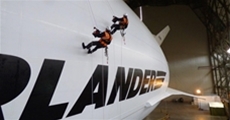The world’s largest aircraft returned to the skies since its last crash landing in August and flew for three hours today. The $33 million hybrid airship, which is part blimp, aircraft, and helicopter and is the length of a football field, took off over Bedfordshire, in England.

At 5:20 p.m. the Airlander was taken off its mooring mast at Cardington Airfield and after accomplishing all the objectives during a three-hour flight, it landed at 8:15 p.m.
“It was truly amazing to be back in the air. I loved every minute of the flight and the Airlander itself handled superbly. I am eager to get back into the cockpit and take her flying again,” said Chief Test Pilot, Dave Burns who was accompanied by Experimental Test Pilot, Simon Davies.
Airlander’s flight test program began in August 2016 when the airship flew twice around Cardington Airfield. Its cockpit crashed on the second test flight following a heavy landing but the two test pilots and ground crew were reported alive and well. The crash led to a nine month of assessment and repair phase, which brought in a more powerful and more maneuverable Mobile Mooring Mast (MMM), and the additional “inflatable landing feet” of the Auxiliary Landing System (ALS).
Hybrid Air Vehicles (HAV), the British manufacturer of the giant helium-filled airship said that the ALS performed as expected on landing, and the Flight Test Team were very pleased with the initial analysis of this new addition to Airlander’s landing system.

The company noted in their press release that today’s flight successfully achieved the three test objectives:
To conduct a full test flight – i.e. complete a safe take-off, flight, and landing of the aircraft.
To establish basic handling characteristics of Airlander within a well-defined flight envelope including assessment of the new ALS.
To collect flight performance data, such as handling, airspeed and all vehicle systems, for post-flight analysis. (This increases the understanding of the aircraft’s performance, capabilities, and operating envelope.)

“This is a great testament to the tenacity and ingenuity of the team of engineers at Hybrid Air Vehicles, who are continually pushing the boundaries of aviation with this amazing aircraft,” said Technical Director, Mike Durham.
HAV officials are hopeful that the Airlander 10 will usher in the era of the new generation of airship, and provide an ultra-stable, powerful, and long endurance platform that will be useful in many ways. With a price tag of $33 million dollars, (£25m) — less than one-tenth of the cost of jetliners– the airship could be used for search and rescue, border control, coast guarding, crowd monitoring, security, academic research, filming, and also for transportation of passengers and cargo. Moreover, the mission and operations could be achieved from door-to-door, even in remote areas with no runway or infrastructure.
According to HAV, the airship “will have a hugely positive impact on the world by providing low carbon aviation and brand new capabilities in the sky.” Those capabilities are lifting 10 tons of payload over longer distances, less fuel consumption than an airplane, ability to rise to 20,000 feet, staying aloft for five days on manned flights, and reaching speeds up to 90 miles an hour.







Leave a Reply